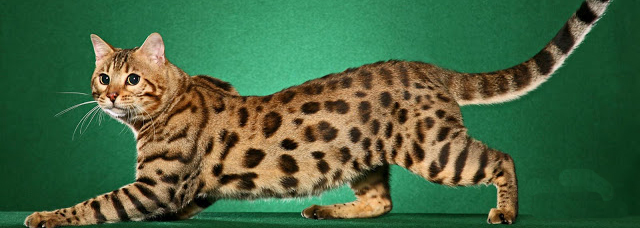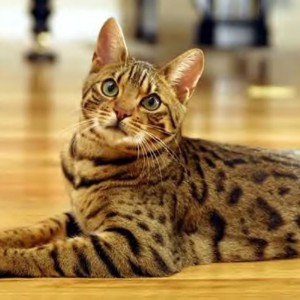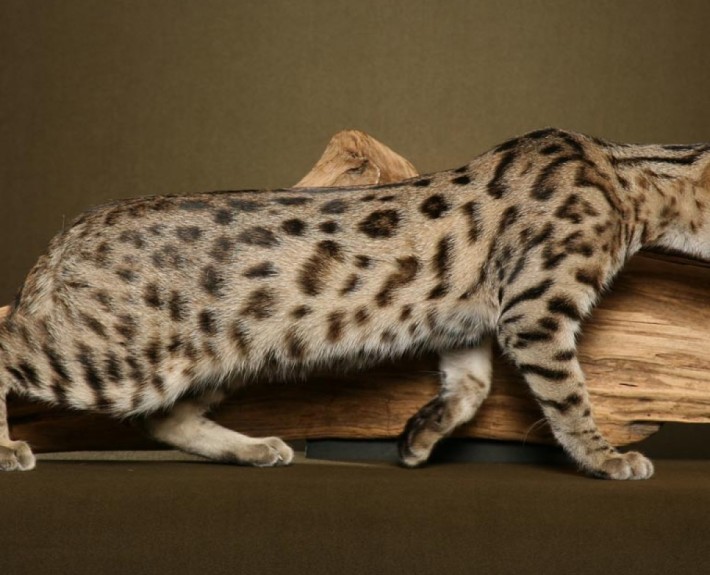Bengal

Meoww!!
If you love a cat with an exotic look but without the size and danger of a wild cat, the Bengal was developed with you in mind.
In 5 Words
- Adorable
- Dog Friendly
- Intelligent
- Curious
- Active
Snapshot
Size: about 16 inches
Weight: 10 – 15 pounds
Origin: United States of America
Life Span: 12 to 16 years
Colour: Baby Bengals color up very gradually, but here are “Vanilla” and “Chocolate” to give you the idea. Bengals are also accepted in black, which is called Melanistic. Silvers have recently been accepted for showing.

Characteristics
Learn About the Bengal
In 1889, Harrison Weir wrote Our Cats and All About Them and this is where the ALC/domestic cross was first mentioned. In 1934, the earliest mention of a confirmed ALC/domestic cross appears in a Belgian scientific journal. In 1941, an article was published with one cat kept as pet. In 1946, Jean Mill who became a great influence of the development of the Bengal cat presented a term paper for her genetics class on crossbreeding cats.
Early breeders like Greg and Elizabeth Kent developed their own line of Bengals using Egyptian Maus and ALCs. It became a successful line and numerous modern Bengals are going to find it in their pedigree. Even though it has become a famous breed with more than 60,000 cats registered with TICA, not all cat registries recognize them. One of the largest cat registries, Cat Fanciers’ Association does not accept any hybrids.
In the 1960s and 1970s, there were a lot of activities with breeding hybrids, but there was no huge effort to develop an actual breed from those. Several cat clubs familiar with hybrids were materialized, and the Bengal were oriented by William Engler, a breeder and a member of the Long Island Ocelot Club. The production of Safaris and Bengals were detailed in the club newsletters that were published.
Bengal cats have wild-looking markings with rosettes, huge spots, light belly and a body structure suggestive of the leopard cat. Its rosette spots appear only on the sides and back, and stripes elsewhere. It also has horizontal striping along the eyes and foreleg striping.
The Bengal cat is usually snow-spotted or brown-spotted. Although there are numerous colors, snow and brown are the only colors that the Governing Council of the Cat Fancy recognizes. With brown Bengals, there are either spotted or marble markings. The rosetted is included in the spotted variation with a spot surrounded by a dark line. Snow Bengals are either spotted or marble but are also separated into blue eyes and other colors. The International Cat Association identifies numerous colors such as silver, sepia, mink, seal lynx point and brown.
Bengal cats are very intelligent cats who love to bond with their owners. They love to intermingle with their people and always love to be in the center of a family activity. They have very high activity levels and love to play, run and leap. They are marvelous jumpers and climbers. They can also be mischievous at times. They are not a cat to be overlooked. They can demand a lot of attention but will always be entertaining you with their antics.
They are really affectionate. They can be easily trained with their “dog like” personality. They can be trained to shake hands, fetch, and even be walked on a leash. Several Bengals love water and play with it. They may scoop their water dishes using their paws, or follow their owners around even to the bathroom. They are fun, affectionate, magnificent pets and are great with dogs and children. They are muscular and medium sized cats. They can shimmer in sunlight due to their glitter gene. They may retain the look of the wild but they have the temperament of a well balanced domestic cat.
Bengals have genetic health problems that can be an issue particularly if you aren’t vigilant of whom to buy it from. One of the possible problems is polycystic kidney disease. But, DNA tests are now accessible to help remove affected cats from the reproduction pool. They may also be prone to some contagious diseases like feline trichimonas foetus and infectious peritonitis, a protozoal infection which causes diarrhea. A responsible breeder should make an effort to identify if these problems exist.
They have a short, soft, luxurious coat which is easy to maintain with weekly brushing. They will love the attention. If you are able to brush them, there will be fewer hairballs and dust bunnies around the house. The rest is basic care. You can trim the nails weekly. Make sure to check the ears weekly for a bad smell or redness that can be infection. If the ears appear dirty, you can wipe it with dampened cotton ball with a veterinarian approved gentle cleanser. Brush their teeth regularly with pet toothpaste. Teeth brushing and nail trimming should be done while he or she is still a kitten so they’re going to get used to it.






